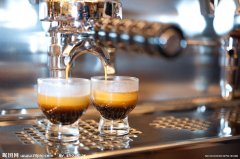Italian coffee machine frothing tips and some advice
Have you ever had a cappuccino like this? It looks like a glass of art, but it tastes silky smooth. I hope you did, because that's all there is to a cappuccino. If you've ever had one of these cappuccinos, I think you'll probably agree with me that it's hard to drink a bubbly, fluffy cappuccino. So what makes a "real" cappuccino taste so good? Barista skills, of course. The art of frothing milk is not easy. But with some good advice and a little practice, you'll instantly impress your cappuccino aficionado friends. Coffee lovers are always proud to be able to make their favorite fancy coffee. I am the same. I like single coffee and fancy coffee with various patterns.
However, one of the most important steps in fancy coffee making is to produce high quality foam. There are two ways to foam milk, namely: manual foam and coffee machine foam. Today, I shared with my friends the espresso machine frothing tips and some small frothing guides.
I hope it helps friends.

Italian coffee machine foam tips
1, do not put the steam pipe into the milk, because there may be some condensed water vapor in the steam pipe, so before preparing to make milk bubbles, you need to put it first to drain the excess water in the pipe.
Beginners can insert the thermometer into the container, then insert the steam pipe obliquely into the milk, and then turn on the steam switch.
Slowly adjust the position of the steam nozzle to a little bit from the surface of the milk, but never above the liquid level, otherwise the milk will splash everywhere. When the position is correct, a smooth "hiss" is heard, the milk level starts to rotate, if the steam pipe is not scaled correctly, it will be loud or almost silent, and the milk level may appear large bubbles.
4, when the milk foam has continued dense, in the steam pipe buried a little deeper, let the steam continue to warm the milk. The steam pipe should be buried at an angle that allows the milk to spin.
5, the temperature reaches 60 degrees ~65 degrees, when the hand feels slightly hot, you can turn off the steam switch.
6, with a wet cloth will adhere to the steam pipe on the milk wipe clean, and then put a steam, the steam pipe residual milk with steam spray together, so as not to block the steam pipe after the milk dried.
At this point, Wang Sen coffee training school teachers will share so much at first, more will be indigestion. Friends can also try it themselves according to the above methods. If you play a few more times, you will definitely be able to play satisfactory milk bubbles.
Some tips and tricks for foaming milk
Espresso machines: All espresso machines currently on the market have steam pipes for frothing milk. Some manufacturers decided to add turbo nozzles to their steam pipes to help their customers. If you have any of these on your coffee machine, please remove them as much as possible, because they won't help us with what we're about to do.
Pull flower cup: preferably stainless steel pull flower cup with water outlet. You need a pull cup that changes temperature with the milk so you can feel the temperature of the milk at all times without steaming it too hot, and stainless steel has this property. The water outlet can help you when you pull flowers.
Milk: The milk used in latte drinks has a fat content of about 3%. The less fat, the harder the foam. And you want smooth foam (so forget fat-free cappuccino).
About frothing: The main thing to keep in mind when frothing is to stop when the temperature reaches the right point. The appropriate temperature is 55 - 65°C, depending on your taste. Too much frothing can curdle milk and change its texture (and cappuccino can be too hot). Overheated milk can also make the foam too hard. How different is the foam? Here are some typical examples:
Foaming: If you are distracted or unfocused while frothing, it is easy to cause the steam pipe to be above the surface of the milk rather than just below it. The result of this is splashing milk and producing larger milk bubbles. Of course you still get a lot of foam in the pull cup, but it will taste bad.
Too hard: hard foam looks stiff and when you pour it into coffee it doesn't mix with the coffee, but instead accumulates on top of your coffee like fluffy beaten cream. If beaten a little longer, it would be stratified, 90% runny milk, and a thick hard foam lid floating on top. When you pour it into your coffee, the milk comes out of the cup first, and you have to scoop the foam into the cup with a spoon.
Smoothness: If you do everything right, the milk looks smooth and creamy when you pour it out, a bit like yogurt. The milk and your espresso blend perfectly together, and crema colors the surface of the milk, creating the typical brown edge of cappuccino.
Re-beaten milk also often produces hard foam. The trick is to produce the right amount and quality of foam in the pull cup at the right temperature. To foam well, you have to know how fast your machine heats the amount of milk you want.
A good tip is to start frothing by not serving less than two cappuccinos at a time.

About the steam in the coffee machine:
1. After the machine has reached the correct temperature, turn on the steam switch, drain the water that will always be present in the steam pipe, and then turn off the steam switch.
2. Place the nozzle below the surface of the milk and turn on the steam. If you turn on the steam when the nozzle is above the liquid level, you get bigger bubbles, and you have to work hard to get rid of them.
3. Slowly bring the nozzle to the surface of the milk. Stop just as it breaks the surface. Now air is sucked into the milk, and you hear a typical hissing sound. If you accidentally lift the nozzle above the water, the pressurized air will blow onto the milk instead of into it, creating large bubbles.
4. At this stage, there is no doubt that you have formed small and medium-sized bubbles on the surface of the milk. Now we will try to remove them. There will be a vortex where the air blows into the milk. All bubbles on the surface are pulled into the vortex and disappear. It is important to place the nozzle in the correct position to avoid creating new bubbles.
5. Now you have a glass of texture formed by tiny bubbles. Put your free hand on the cup to feel the milk temperature. As the foam rises, you carefully lower the steam pipe so that it touches the milk. If you are satisfied with the amount of foam and the milk is not warm enough, lower the nozzle into the milk. Now the milk starts to swirl. This allows the milk to be heated evenly by the steam. When your hands feel a little warm, keep the nozzle below the liquid level and turn off the steam.
Whirlpool milk and pour:
A lot of times you still have bubbles in your foam. A good way to get rid of these bubbles is to tap the cup hard on the bench. Don't tap too many times to avoid creating too much foam. A good way to tell if milk is "thick" enough is to rotate the cup so that the milk begins to swirl. You have to make a few cappuccinos to learn what milk should look like.
Some suggestions to check if the foam is good enough:
You can also tilt the cup to see how thick the milk is at the outlet. Consider the following examples:
Milk should not be too thick, because if it is too thick it will not mix well with coffee.
Milk should look like you're pouring yogurt (it might sound like a strange metaphor, but it's actually just that)
Pour the milk slowly. If it looks fluid, wait a few seconds. By waiting for the air that has been blown into the milk to rise to the surface, the milk can be stratified and the milk foam floats on top. It's like what happens when dark beer is poured. To get the right creamy properties, you now need to blow the milk out of the swirl to mix it up. You might get a nice cappuccino for doing that, but probably not two.
Important Notice :
前街咖啡 FrontStreet Coffee has moved to new addredd:
FrontStreet Coffee Address: 315,Donghua East Road,GuangZhou
Tel:020 38364473
- Prev

Three methods of making Coffee Milk foam there are three main ways to make coffee milk foam at home
There are three main ways to make coffee foam at home. But either way, it needs to be done with whole milk, which has a fat content of more than 3.7%. Friends who have an Italian coffee machine can generally be made with an Italian coffee machine. The method of making milk foam in the coffee machine Lao Yang mainly used this method in the early days of the Italian coffee machine, but he didn't master it well all the time. Below
- Next

The third factor affecting milk foam: common sense of coffee flower drawing in the form of steam tube
The steam outlet mode of steam pipe is mainly divided into two types: external expansion type and centralized type. Different forms of steam pipe, the steam intensity and steam output will be different, coupled with the change of the position of the outlet hole and the number of holes, it will cause the difference between the angle and the way when milking. When dispensing milk, the expanded steam pipe should not be too close to the edge of the steel cup, so that it will not be easy.
Related
- What is the meaning of lactic acid fermentation with coffee bean treatment?
- How to judge the state of foam by sound?
- How does the latte pull out the unicorn pattern? Come to get for a little trick to improve the flower pull!
- Will flower pulling affect the taste of the latte?
- Do you know the history of coffee?
- The difference between honey treatment and sun washing what is raisin honey treatment?
- What kind of milk can a novice use to make coffee foam to keep the foam longer? The correct method and skills of milking tutorial sharing
- Why do washed coffee beans taste sour? Flavor characteristics of washed Coffee
- Introduction to the skill of how to practice the size and height of water injection around the circle of hand-brewed coffee
- How do beginners practice coffee flower drawing from scratch?

